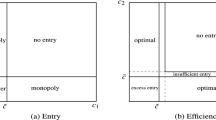Abstract
In this paper, contestability theory is examined under conditions of asymmetric information. Signals of economic profitability to potential entrants are the incumbent's list price and accounting rate of return. A disequilibrium analysis indicates that, while potential entry imposes a price discipline, incumbents can earn profits, although not indefinitely under stable conditions. Also, there may be wasteful entry even into industries where prices approximate the optimum.
Similar content being viewed by others
References
Baumol, William J., Panzar, John C. and Willig, Robert D. (1982)Contestable Markets and the Theory Industry Structure, New York: Harcourt, Brace, Jovanovich.
Baumol, William J., Panzar, John C. and Willig, Robert D. (1983) ‘Contestable Markets: An Uprising in the Theory of Industry Structure: Reply’,American Economic Review,73, 491–6.
Baumol, William J., Panzar, John C. and Willig, Robert D. (1986) ‘On the Theory of Perfectly Contestable Markets’, in Joseph E. Stiglitz and Frank Mathewson (eds.),New Developments in the Analysis of Market Structure Cambridge, Mass.: MIT Press, pp. 339–70. (Includes a summary of discussions of the paper by several scholars.)
Cairns, Robert D. and Mahabir, Dhanayshar (1988) ‘Contestability: A Revisionist View’,Economica 55(2), 269–76.
Caves, R. E. and Porter, M. E. (1977) ‘From Entry Barriers to Mobility Barriers: Conjectural Decisions and Contrived Deterrence to New Competition’,Quarterly Journal of Economics, May, 241–61.
DeGroot, Morris H. (1970)Optimal Statistical Decisions, New York: McGraw Hill.
Fisher, Franklin M. and McGowan, John J. (1983) ‘On the Misuse of Accounting Rates of Return to Infer Monopoly Profits’,American Economic Review 73(1), 82–97.
Harrington, Joseph E., Jr. (1987) ‘Oligopolistic Entry Deterrence under Incomplete Information,’Rand Journal of Economics,18(2), 211–31.
Kay, J. A. and Mayer, C. P. (1986) ‘On the Application of Accounting Rates of Return’,Economic Journal,96, 199–207.
MacLeod, W. Bentley (1987) ‘Entry, Sunk Costs and Market Structure’,Canadian Journa of Economics,XX(1), 140–57.
Masson, Robert and Shaanan, Joseph (1982) ‘Stochastic Dynamic Limit Pricing: An Empirical Test’,Review of Economics and Statistics,64, 413–23.
Matthews, Steven A. and Mirman, Leonard J. (1983) ‘Equilibrium Pricing: The Effects of Private Information and Stochastic Demand’,Econometrica 51(4), 981–96.
Mood, Alexander M. and Graybill, Franklin A. (1963)Introduction to the Theory of Statistics 2nd ed., New York: McGraw-Hill.
Morgenstern, Oskar (1963)On the Accuracy of Economic Observations, Princeton University Press.
Nalebuff, Barry and Scharfstein, David (1987) ‘Testing in Models of Asymmetric Information’,Review of Economic Studies,LIV, 265–77.
Radner, Roy (1985) ‘Repeated Principal-Agent Games with Discounting’,Econometrica,53(5), 1173–98.
Smith, James L. (1981) ‘Non-Aggressive Bidding Behavior and the “Winner's Curse”’,Economic Inquiry,XIX, 380–8.
Stigler, George (1968)The Organization of Industry, Homewood, Ill.: Irwin.
Author information
Authors and Affiliations
Additional information
I thank Marcel Boyer, Mukesh Eswaran, John Galbraith, Barry Ma, Barbara Spencer, Vicky Zinde-Walsh and an anonymous referee for helpful comments on an earlier draft. Research on this paper was supported by the FCAR and the SSHRCC.
Rights and permissions
About this article
Cite this article
Cairns, R.D. Asymmetry of information and contestability theory. Rev Ind Organ 9, 99–107 (1994). https://doi.org/10.1007/BF01024222
Issue Date:
DOI: https://doi.org/10.1007/BF01024222




